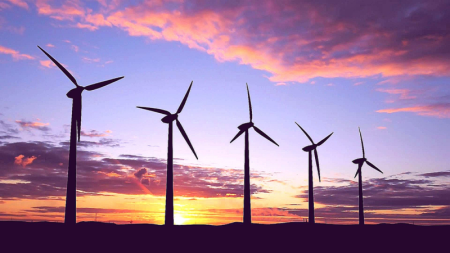
Lately, there has been an obvious slowdown of global “green transition” framed as a strategic goal of Western economic policy. Moreover, there has been news about abandoning green technologies and boosting production of fossil fuels. The process observed is determined by a mix of technological, economic and political factors.
First, the existing solar and wind generation technologies appeared not enough reliable. News feeds regularly report issues related to iced wind turbine blades, unstable solar panel functioning over lacking sunny hours or excessively nasty weather. Thus, green energy is hardly stable or reliable.
The estimated electricity cost based on the ratio of energy obtained from a particular source to the amount spent on its production (“energy return on investment” indicator, EROI) shows that the figure is 30:1 or higher for coal, and about 100:1 for hydropower. Natural gas, considered the most eco-friendly mineral fuel, has an EROI of 20-30:1 in importing countries, and 75:1 or higher in gas-producing Russia. Meanwhile, Germany’s best offshore complexes reveal wind energy EROI of 16:1, and the average figure is lower. Therefore, although wind accounts for over 21% of that country’s output, its industry has been stagnant in the last few years — construction pace for new wind turbines has slumped. In solar energy, the situation is even worse: low efficiency of panels (6-8%) and dependence on the light conditions have brought the European EROI to the level of 1,6:1, while in America’s Arizona it barely reaches 3,8:1 out of the 4:1 needed for payback. In addition, instability makes renewable energy sources require batteries to operate, whose high cost provides a three- or even fourfold increase in the price of kWh from “green” sources.
The evidence from practice has shown that renewables are not profitable to businesses producing relevant machinery. Thus, wind turbine manufacturers have been working in the red for 5 years now, and the situation has worsened recently. In 2023 alone, the overall losses in the sector’s four major companies (GE Renewable Energy (USA), Vestas (Denmark), Siemens Games and Nordex (Germany)) exceeded €5bn.
Wood Mackenzie analysts deem inflation as a reason behind the industry's unprofitability, as it brought up the cost of consumables. Since the early pandemic days, prices have skyrocketed in all but every sphere: raw materials, labor, logistics services, and since 2022, this has been supplemented by geopolitical factors as well, such as the war in Ukraine or between Israeli and Palestine. The market has become monopolized for those producing renewables-related materials. Thus, China accounts for half of the planned lithium plants, and Indonesia enjoys 90% of nickel purification capacities. This does not necessarily imply supply chain bottlenecks, but monopolization does entail higher prices. Therefore, companies producing equipment for renewable energy sources are compelled to send those up. Thus, America’s GE did so by 20% but only partially compensated for the increased material costs.
Inflation and increased material prices are not the only reasons. Thus, manufacturers have long been racing to build more powerful wind turbines, neglecting their reliability. As a result, their costs for warranty service grew sharply, entailing losses. In 2022, backup service of wind turbines cost Germany’s Siemens €920mln. In late June 2023, the company reported numerous cases of manufacturing defects, with their elimination worth at least €1bn. The Danish Vestas company has been also claiming issues with repairing failed equipment over the past 3 years. To combat growing losses, the American GE came up with the idea of reducing the number of wind turbine models from 40 to 9, and rotors for them — from 15 to 4.
Machine builders’ woes highlight the generally instable renewable energy situation as a business. Despite all the positive aspects and political will, it is becoming increasingly difficult to develop the sector. The current technological level makes green energy still acceptable to countries of the “golden billion” alone, where it is subsidized from national budgets.
But even subsidies cannot fully solve its problems. Thus, “another blow” to green transformation plans was dealt in the United States, with its oil giant Occidental Petroleum selling the largest carbon capture plant for $200 million, a quarter of the overall investment. Over its 13 years in service, it never operated at more than a third of its capacity, a Bloomberg investigation found. The reason is simple — carbon capture and storage technologies have proven ineffective. They require using large fans to move ambient air through special filters and solutions, i.e. equipment service requires electricity, whose production causes fossil fuels burning and extra CO2 volumes. As a result, almost two decades into its implementation, the total carbon capture capacity worldwide is only about 45 million tons of CO2 per year — mere four percent of amounts needed to achieve net-zero emissions by 2050.
In the current situation, developing countries, primarily India and China, are returning to proven energy sources, particularly coal. Thus, the last three years have seen China expand production by 21% to 4.7 billion tons, while India plans to increase it to 1 billion tons in 2024. The two plus Indonesia commissioned 59 gigawatts of new coal-fired power plants last year, and plan another 131, Global Energy Monitor stated.
Saudi Aramco CEO Amin Nasser said on March 18 that energy transition has failed and politicians must accept this fact, which is obvious to everyone. “We need to put aside the ‘fantasy’ of phasing out oil and gas, as demand for fossil fuels is expected to grow in the coming years. We should invest in them,” he said, recalling that despite the $9.5 trillion invested in renewables in 20 years, they have not been able to replace hydrocarbons — wind and solar energy account for only four percent of total energy production so far.
So, without a technological breakthrough, power plant operators and industrial facilities using fossil fuels will have no economic reasons to switch to renewable energy sources in the medium term. But amid political and public pressure, they will most likely be forced to feign interest in those.









